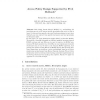151 search results - page 13 / 31 » Using trust and risk in role-based access control policies |
94
Voted
SACMAT
2004
ACM
15 years 5 months ago
2004
ACM
Ubiquitous computing uses a variety of information for which access needs to be controlled. For instance, a person’s current location is a sensitive piece of information, which ...
EUROSYS
2010
ACM
15 years 4 months ago
2010
ACM
Combining access control with weakly consistent replication presents a challenge if the resulting system is to support eventual consistency. If authorization policy can be tempora...
111
click to vote
ICCS
2009
Springer
15 years 6 months ago
2009
Springer
Role Based Access Control (RBAC) is a methodology for providing users in an IT system specific permissions like write or read to t abstracts from specific users and binds permiss...
WETICE
2008
IEEE
15 years 6 months ago
2008
IEEE
The Bell-LaPadula security model is a hybrid model that combines mandatory access controls and discretionary access controls. The Bell-LaPadula security model has been widely acce...
CSFW
2010
IEEE
15 years 3 months ago
2010
IEEE
—Although policy compliance testing is generally treated as a binary decision problem, the evidence gathered during the trust management process can actually be used to examine t...


